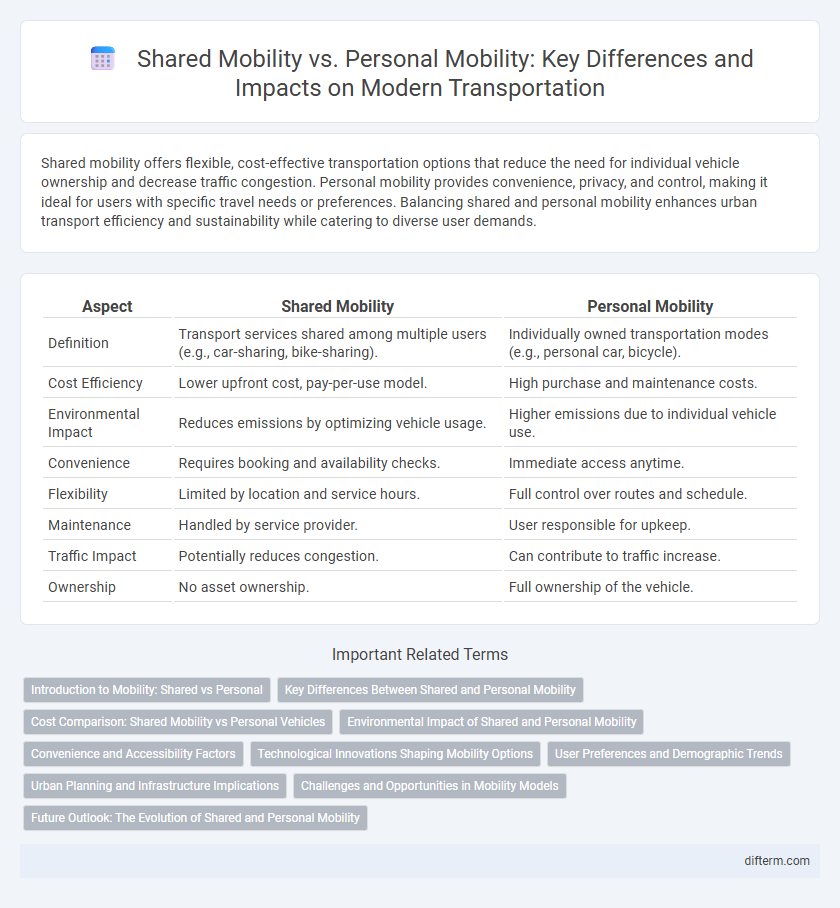Shared mobility offers flexible, cost-effective transportation options that reduce the need for individual vehicle ownership and decrease traffic congestion. Personal mobility provides convenience, privacy, and control, making it ideal for users with specific travel needs or preferences. Balancing shared and personal mobility enhances urban transport efficiency and sustainability while catering to diverse user demands.
Table of Comparison
| Aspect | Shared Mobility | Personal Mobility |
|---|---|---|
| Definition | Transport services shared among multiple users (e.g., car-sharing, bike-sharing). | Individually owned transportation modes (e.g., personal car, bicycle). |
| Cost Efficiency | Lower upfront cost, pay-per-use model. | High purchase and maintenance costs. |
| Environmental Impact | Reduces emissions by optimizing vehicle usage. | Higher emissions due to individual vehicle use. |
| Convenience | Requires booking and availability checks. | Immediate access anytime. |
| Flexibility | Limited by location and service hours. | Full control over routes and schedule. |
| Maintenance | Handled by service provider. | User responsible for upkeep. |
| Traffic Impact | Potentially reduces congestion. | Can contribute to traffic increase. |
| Ownership | No asset ownership. | Full ownership of the vehicle. |
Introduction to Mobility: Shared vs Personal
Shared mobility offers cost-effective and environmentally friendly transportation options by enabling users to access vehicles such as bikes, scooters, or cars on-demand, reducing the need for private vehicle ownership. Personal mobility relies on privately owned vehicles, providing convenience and control but often contributing to increased traffic congestion and higher carbon emissions. Trends in urban planning increasingly favor shared mobility solutions to enhance sustainability, reduce road space usage, and lower individual transportation costs.
Key Differences Between Shared and Personal Mobility
Shared mobility services, such as bike-sharing, carpooling, and ride-hailing, emphasize accessibility, cost-efficiency, and reduced environmental impact by maximizing vehicle utilization. Personal mobility, including privately owned cars and motorcycles, offers greater convenience, privacy, and flexibility but often results in higher expenses and environmental footprints. The key differences lie in ownership, cost structure, user experience, and sustainability outcomes.
Cost Comparison: Shared Mobility vs Personal Vehicles
Shared mobility options such as ride-sharing, carpooling, and bike-sharing often reduce overall transportation costs by eliminating expenses related to vehicle ownership, including maintenance, insurance, and depreciation. Personal vehicles, while offering convenience and autonomy, incur significant fixed and variable costs averaging thousands of dollars annually, influenced by fuel prices, repairs, and parking fees. Cost efficiency of shared mobility solutions becomes especially pronounced in urban areas with dense populations and well-developed public transportation infrastructure.
Environmental Impact of Shared and Personal Mobility
Shared mobility significantly reduces per capita greenhouse gas emissions by maximizing vehicle occupancy and minimizing the number of vehicles on the road. Personal mobility, dominated by privately owned cars, often leads to higher emissions due to low occupancy rates and increased traffic congestion. Studies indicate that widespread adoption of shared mobility services can decrease urban carbon footprints by up to 30%, contributing to more sustainable transportation systems.
Convenience and Accessibility Factors
Shared mobility services significantly enhance convenience by offering on-demand access to various transportation options without the need for vehicle ownership, reducing parking challenges and maintenance responsibilities. Personal mobility provides unparalleled accessibility in remote or underserved areas where shared services may have limited coverage, ensuring consistent availability for users. Both modalities contribute to a diversified transportation ecosystem by balancing flexibility, cost-effectiveness, and spatial accessibility.
Technological Innovations Shaping Mobility Options
Technological innovations such as autonomous vehicles, IoT connectivity, and advanced data analytics are revolutionizing shared mobility by enhancing efficiency, safety, and user accessibility. Personal mobility is simultaneously transformed through electric scooters, smart bikes, and personalized navigation systems integrating real-time traffic data and AI-driven route optimization. These advancements are driving a shift from ownership to service-based mobility models, reducing urban congestion and environmental impact.
User Preferences and Demographic Trends
User preferences in shared mobility often prioritize cost-effectiveness, environmental sustainability, and convenience, especially among younger demographics such as millennials and Gen Z. Personal mobility remains favored by older age groups and suburban residents due to the desire for privacy, control, and flexibility. Demographic trends indicate a rising adoption of shared mobility services in urban areas with high population density and tech-savvy users seeking alternatives to car ownership.
Urban Planning and Infrastructure Implications
Shared mobility solutions reduce traffic congestion and parking demand in urban areas, allowing city planners to reallocate public space for pedestrian zones and green infrastructure. Integrating shared mobility requires adaptive infrastructure, including dedicated pick-up/drop-off points and dynamic traffic management systems to optimize flow and safety. Personal mobility, while offering convenience, imposes higher demands on parking infrastructure and contributes to urban sprawl, challenging sustainable urban planning efforts.
Challenges and Opportunities in Mobility Models
Shared mobility faces challenges such as managing demand variability, ensuring vehicle availability, and addressing user privacy concerns, while personal mobility struggles with traffic congestion, parking shortages, and environmental impact. Opportunities in shared mobility include reducing urban traffic, lowering carbon emissions through efficient fleet utilization, and fostering inclusive access to transportation. Personal mobility innovations focus on integrating electric vehicles and smart infrastructure to enhance user convenience and sustainability.
Future Outlook: The Evolution of Shared and Personal Mobility
Advancements in technology and urbanization are driving a convergence of shared mobility services and personal vehicle ownership, reshaping future transportation landscapes. Integration of electric vehicles, autonomous driving, and real-time data analytics will enhance convenience, reduce environmental impact, and optimize resource usage in both shared and personal mobility sectors. Consumer preferences are expected to shift toward flexible, multi-modal solutions that balance cost efficiency, accessibility, and sustainability, influencing urban planning and mobility ecosystems globally.
shared mobility vs personal mobility Infographic

 difterm.com
difterm.com